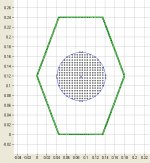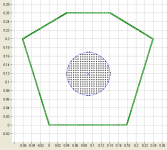It's way to low in sensitivity. The higher Q doesn't do anything for the frequency range over which it operates.
Oh, the reason I mentioned Q is to prove it is a beffier driver, it has less distortion in mid bass than the SS even though there is a hump due to the Q.
John, what do you think of LX 521 bridge, will adopting it make the speaker more stable?
I don't feel a bridge layout will have much effect other than reducing the sensation of baffle vibration when touched. There really isn't sufficient volume displacement associated with the baffle movement at woofer frequencies for it to radiate any significant sound. The more significant source of baffle vibration seems to emanate from the lower midrange and in that case fixing the baffle to the entire speaker structure should be beneficial. Of course, if you want to build it as a bridge it's you prerogative.
It looks like the Vifa tweeters OX20SC00-04 are not available in Europe. Anyone know otherwise?
If that is the case please see if there is a similar sized tweeter available. I would be happy to adapt the system to what is available. Alternately I would be happy to supply the tweeters at my cost plus shipping. That would be about $80/set of 4 plus shipping by Priority Mail International (about $17 to the UK).
I expect to have the plan set ready by mid December at the latest, hopefully a little sooner.
A kind offer John, thanks. I cannot see any similar price and quality drivers, that are that small.
For those with Note speakers very close to the back wall, would front firing tweeters be preferred to front and rear?
I consider the rear tweeter an option. I am presently running only fronts. I don't think it makes much difference with the x-o at 6 k Hz. But the rear can always be wired with a switch so it can be turned on or off.
Well, the SS2004 is more spendy and a little bigger but I'm sure they could work? If you only need two a few extra € sure won't feel too bad in the end. 
Europe Audio also lists Dayton ND20FA & FB on their homepage.
An externally hosted image should be here but it was not working when we last tested it.
Europe Audio also lists Dayton ND20FA & FB on their homepage.
Well, the SS2004 is more spendy and a little bigger but I'm sure they could work? If you only need two a few extra € sure won't feel too bad in the end.
An externally hosted image should be here but it was not working when we last tested it.
Europe Audio also lists Dayton ND20FA & FB on their homepage.
I would strongly recommend using the correct Vifa tweeter. The SS will not work and the Dayton would require surgery to even see if it would work.
I've meaning to ask this question for some time: why does none of the dipole projects by either JohnK or SL make use of asymmetrical driver placement within the baffle or even an asymmetrical baffle, such as one straight and one slanted side?
This would serve to smear the transitions somewhat. FR-wise, it would probably be just as easy to equalize, and it might also serve to smear some things in the temporal response.
This would serve to smear the transitions somewhat. FR-wise, it would probably be just as easy to equalize, and it might also serve to smear some things in the temporal response.
I've meaning to ask this question for some time: why does none of the dipole projects by either JohnK or SL make use of asymmetrical driver placement within the baffle or even an asymmetrical baffle, such as one straight and one slanted side?
This would serve to smear the transitions somewhat. FR-wise, it would probably be just as easy to equalize, and it might also serve to smear some things in the temporal response.
It results in asymmetric horizontal response.
By the way, the Note II Rs will be at DIY New England this weekend (tomorrow) in case you missed mention of it on other boards. Hope to release the design by the Dec 7th.
Yes, but is that necessarily a bad thing? Specifically, you would try to point the side with the better high end dispersion towards the listener rather than the side walls. Also, wouldn't the advantages in terms of time domain behavior offset any disadvantages from non-symmetrical horizontal profiles?
Too bad, my last trip to the US for this year ended about a week ago...
Too bad, my last trip to the US for this year ended about a week ago...
I though I might post this just for the record. I have packed up the Note for DIY NE tomorrow, 12/1/12. After that I set up my NaO II RS system. As a result I am reconsidering the switch from U-frame woofer system to the dipole. The Note II RS may ultimately be released with a U-frame woofer. I will discuss the reasons for this when the final decision is made. Let me just say that I was overwhelmed by my exuberance over presenting a full range dipole system, thus abandon my usual pensive approach and my past experience that the u-frame is the better way to go.
Capslock: My understanding is the best possible time domain behavior for a dipole is to have the smallest possible baffle, at least at higher frequencies where baffles tend to become acoustically large. Smallest possible will be left-right symmetric, basically shrink-wrapped around the drivers.
EDGE models suggest that a shrink-wrapped round baffle is better than a larger baffle of irregular shape, i.e. the polar contours are more consistently parallel. An irregular baffle will give flatter response for some listening angles but the polar contours will cross, so it's not possible to equalize the response effectively.
EDGE models suggest that a shrink-wrapped round baffle is better than a larger baffle of irregular shape, i.e. the polar contours are more consistently parallel. An irregular baffle will give flatter response for some listening angles but the polar contours will cross, so it's not possible to equalize the response effectively.
Last edited:
Capslock: My understanding is the best possible time domain behavior for a dipole is to have the smallest possible baffle, at least at higher frequencies where baffles tend to become acoustically large. Smallest possible will be left-right symmetric, basically shrink-wrapped around the drivers.
EDGE models suggest that a shrink-wrapped round baffle is better than a larger baffle of irregular shape, i.e. the polar contours are more consistently parallel. An irregular baffle will give flatter response for some listening angles but the polar contours will cross, so it's not possible to equalize the response effectively.
Not sure what you are referring to when you say polar contours will cross. But as far as time domain behavior, once a dipole source is equalized to some target band pass response, like a midrange with 100 Hz high pass and 2k Hz low pass, it with have the same time domain behavior as a a box speaker with the same response.
Crossing polar contours
I made two sims with EDGE, both using a 15cm driver (10cm piston diameter). One version has a minimal hexagonal baffle and the other baffle is larger. Polar contours cross with the larger baffle at 2.5 kHz. A larger baffle than this will have contours crossing repeatedly. These are 5° increments out to 45°.




I made two sims with EDGE, both using a 15cm driver (10cm piston diameter). One version has a minimal hexagonal baffle and the other baffle is larger. Polar contours cross with the larger baffle at 2.5 kHz. A larger baffle than this will have contours crossing repeatedly. These are 5° increments out to 45°.




Finally found a European seller for that tweeter (the Tymphany).
Speaker & Co
Neo3PDR is near 100Euros these days!!!
Speaker & Co
Neo3PDR is near 100Euros these days!!!
Last edited:
DIY NE has come and gone. The Note II RS was very well received. The bass problem I alluded to was still present and I will have to correct it. But there was not problem with deep authoritative bass using the SLS woofer. There was also a pair of Orion 4's present. My impression was that the shelving down of the tweeter in the Orion 4 takes a lot of the air and space out of the speaker sound. It would say that to shelf or not to shelf is really dependent on the source material. On large orchestral works it may sound OK but on my CD of Chopin piano concertos it sounded like some one threw a blanket over the sound board. The impact of the hammers hitting the strings was lost. In any event, with the miniDSP in the loop such a shelf can be inserted or removed in the Note with a mouse click and you have your choice.
This week I will be working of the woofer system. I will try to determine the problem with the dipole woofer (could be a simply enclosure resonance). I will also look at the SLS woofer in a U-frame as I have a feeling that over all the U-frames do perform better in an arbitrary room.
This week I will be working of the woofer system. I will try to determine the problem with the dipole woofer (could be a simply enclosure resonance). I will also look at the SLS woofer in a U-frame as I have a feeling that over all the U-frames do perform better in an arbitrary room.
I'm afraid I don't agree with the Edge simulations. They show the dipole peak becoming lower in frequency as the off axis angle increases when it should rise. Source directionality will have some effect on this, but when I run the edge for a point source it does not show the dipole peak rising as it should (and does). Here are some measured data for a dipole with symmetric front and rear sources. You can see the shift of the dipole peak higher. Additionally, I have mathematically shown that at low frequency any shaped baffle is equivalent to a circular baffle of some effective radius, and it has been shown by others (in text books on acoustics) that at low frequency a circular baffle will behave as a doublet (two sources of equal strength but opposite phase separated by some distance, d). So I am a bit confused when you say that "contours will cross. That will not happen in the 6dB roll off region.
An externally hosted image should be here but it was not working when we last tested it.
- Home
- Loudspeakers
- Multi-Way
- NaO Note II RS